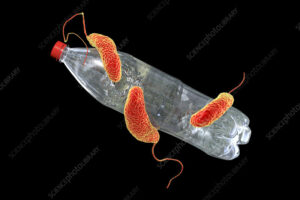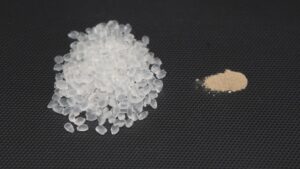THE GARBAGE MAN’s Trash-Eating Bugs

Illustration of Ideonella sakaiensis bacteria degrading a plastic bottle. Credit: Kateryna Kon / Science Photo Library
Beneath the surface of the world we live in lies a vast separate universe, one that knows not and cares not of us: the universe of microbes. Conservative estimates suggest the existence of at least 1 billion different species of microbes on Earth. Scientists have “discovered” but a small fraction. The human body contains a ratio of human cells to microbial cells at around 1: 1.3. In a very real sense, “they” outnumber “us”.
These living creatures are both ancient and terribly timely. They evolved long before the first plants and animals appeared, and their single-celled status means that they can evolve at a breakneck pace by multi-celled (animal) standards. They don’t need 30,000 years. More like thirty. And this nifty little talent, as we will soon see, is very, very helpful.
One of the main characters of THE GARBAGE MAN is the bacterium Ideonella Schechterensis Chewinformis (I. Chew). I made that up, but note the name — It will come up again. I. Chew are magical bugs that eat the most horrid and pernicious waste of all:
Plastic.
Plastic-eating bacteria. Bacteria love chicken bones and dirty diapers and discarded houseplants. But plastic, well, that’s part of the problem with plastic. Nothing eats it; nothing breaks it down. It just sits there and pollutes. There are islands – literally islands – of debris in the Pacific Ocean made up largely of plastic, 1.8 trillion pieces and growing. It’s something out of a horror movie. Google pictures of the Great Pacific Garbage Patch – it will give you nightmares.
BUT WAIT.
Microbes may have – for real – produced the early stages of a solution. In 2001, while digging through a trash dump, a group of microbiologists led by Professor Kohei Oda of the Kyoto Institute of Technology discovered bacteria eating through plastic waste, specifically PET. Polyethylene terephthalate, used for food and beverage containers, number 1 on the recycling symbol and Plastic Public Enemy #1, if you will. The group named the bug Ideonella sakaiensis, after the city of Sakai, where the researchers discovered it (yup, my made-up bugs are named after these real ones!). The bacterium adhered to PET with a thin flagellum and delivered PET-degrading enzymes to the surface.1

Yum! Here’s our hero bug and its breakfast! Source: Chris Givens, The Pipettepen
Scientist are working on commercializing Ideonella, and, in parallel, other solutions. Researchers at the University of San Diego are genetically modifying the bacteria Bacillus subtilis to eat polyurethane, and fusing the spores (read: baby bacilli) into the plastic in order to produce an actual “living” self-degrading water bottle.2

You and me babe, how about it? Source: UC San Diego
And there’s more. Superworms and superbeetles that can survive on plastics alone. Enzyme-only solutions. Even some research findings that non-plastic eating bacteria are evolving to consume plastic.
In conclusion, there is much activity in the land of plastic-eating superheroes, and I fervently hope “real world events” overtake THE GARBAGE MAN’s very evolved bugs sooner rather than later. The world could really, really use a break when it comes to plastic. Until that happens, I’m sticking to my reusable WaterDrop and refilling / reusing the plastics my family consumes. And praying for Mother Earth.
See you next month,
Tessa
1A bacterium that degrades and assimilates polyethylene terephthalate, Science, 11 March 2016
2Biocomposite thermoplastic polyurethanes containing evolved bacterial spores as living fillers to facilitate polymer disintegration, nature communications, 30 April 2024